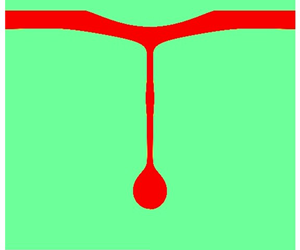Article contents
Simulation of impulsively induced viscoelastic jets using the Oldroyd-B model
Published online by Cambridge University Press: 25 January 2021
Abstract

Understanding the physics of viscoelastic liquid jets is relevant to jet-based printing and deposition techniques. In this paper we study the behaviour of jets induced from viscoelastic liquid films, using the mechanical impulse provided by a laser pulse to actuate jet formation. We present direct numerical simulations of viscoelastic liquid jets solving the two-phase flow problem, accounting for the Oldroyd-B rheology. We describe how the jet extension time and length are controlled by the Deborah number (ratio of the elastic and inertia-capillary time scales), the viscous dissipation described by the Ohnesorge number (ratio of the viscous-capillary and inertia-capillary time scales), as well as the ratio of laser impulse energy to the energy required to create free surface during jet formation and propagation. Using the droplet ejection laser threshold energy of a Newtonian liquid, we investigate the influence of increasing viscoelastic effects. We show that viscoelastic effects can modify the effective drop size at the tip of the jet, while the maximum jet length increases with increasing Deborah number. Using the simulations, we identify a high-Deborah-number regime, where the time of maximum jet extension can be described as  $t_{max} = c_1 De^{1/4}$, with
$t_{max} = c_1 De^{1/4}$, with  $c_1$ depending on the Ohnesorge number and blister geometry, while the length of maximum extension reaches an asymptotic value
$c_1$ depending on the Ohnesorge number and blister geometry, while the length of maximum extension reaches an asymptotic value  $L_{max}^{\infty }$ for
$L_{max}^{\infty }$ for  $De>100$,
$De>100$,  $L_{max}^{\infty }$ depending on the Ohnesorge number and laser energy. The observed asymptotic relationships are in good agreement with experiments performed at much higher Deborah numbers.
$L_{max}^{\infty }$ depending on the Ohnesorge number and laser energy. The observed asymptotic relationships are in good agreement with experiments performed at much higher Deborah numbers.
- Type
- JFM Papers
- Information
- Copyright
- © The Author(s), 2021. Published by Cambridge University Press
References
REFERENCES
- 6
- Cited by



